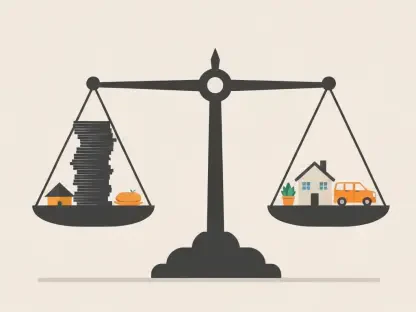In a transformative era for global finance, an estimated $124 trillion in wealth is expected to change hands over the next 25 years, with women emerging as pivotal players in this monumental transfer, positioning them not only as beneficiaries but also as key decision-makers in household finances. As their economic influence grows, financial institutions face a critical challenge: adapting to the unique needs and expectations of this demographic. The gap between current banking services and women’s priorities reveals a pressing opportunity for innovation. With trust and engagement at stake, the industry stands at a crossroads, where meaningful change could redefine long-term relationships with female clients and secure a competitive edge in a rapidly evolving landscape.
Shifting Financial Power Dynamics
Historical Barriers and Modern Progress
The journey of women in finance has been marked by significant hurdles, with systemic restrictions limiting their autonomy until recent decades. Before the 1970s, societal norms often required a husband’s permission or a co-signer for women to access basic financial tools like credit cards. While legal and cultural advancements have dismantled many of these barriers, disparities in financial inclusion persist, particularly in areas like long-term planning and wealth transfer discussions. These gaps often surface during critical moments of inheritance, when the lack of prior engagement can hinder trust-building opportunities. As women increasingly inherit substantial wealth, the need for proactive strategies to address their specific concerns becomes evident, pushing banks to rethink outdated approaches and prioritize inclusive solutions that resonate with this growing demographic.
Rising Influence in Household Finances
Today, women are stepping into roles as primary financial decision-makers, a shift that reflects broader societal changes and economic empowerment. With an unprecedented wealth transfer on the horizon, their influence over family finances is set to expand further, reshaping how resources are managed and invested. However, many women report feeling underserved by current banking systems, often citing a lack of tailored guidance during pivotal life transitions. This disconnect highlights a crucial area for improvement, as financial institutions must adapt to provide relevant support that aligns with women’s evolving responsibilities. By focusing on personalized engagement and understanding the nuances of their financial journeys, banks can build stronger connections and position themselves as trusted partners in navigating this historic shift in wealth dynamics.
Banking Industry Challenges and Opportunities
Gaps in Trust and Personalization
Despite maintaining banking relationships for an average of 9.2 years, a mere 37% of women feel their institutions offer tailored product recommendations, according to recent survey data. Trust levels also raise concerns, with only 75% expressing confidence in their banks to suggest suitable solutions, and 76% believing their providers prioritize supportive rather than exploitative offerings. These statistics underscore a significant disconnect between women’s expectations and the level of personalization they experience. High priorities such as user experience, valued by 93% of female respondents, and quality online customer service, important to 87%, are often unmet. Addressing these gaps requires a fundamental shift in how banks approach client interactions, ensuring that digital platforms and advisory services are intuitive and responsive to individual needs during this era of massive wealth transfer.
Leveraging Digital Engagement for Loyalty
A notable gender difference emerges in how women respond to positive banking experiences, presenting a clear opportunity for institutions to foster loyalty. Survey results indicate that 44% of women, compared to 39% of men, are likely to recommend their banks when satisfied with digital tools, while 41% of women, versus 34% of men, are open to trying new features. This responsiveness suggests that intentional, user-focused digital design can transform satisfaction into advocacy among female clients. As women assume greater control over inherited wealth, banks that invest in seamless online experiences and innovative functionalities stand to gain a competitive advantage. Building trust through meaningful engagement not only strengthens existing relationships but also attracts new clients, making digital innovation a cornerstone of adapting to this demographic shift.
Envisioning a Responsive Financial Future
Strategies for Tailored Support
Looking ahead, financial institutions must adopt targeted strategies to meet the needs of women navigating significant wealth transfers. Essential approaches include designing intuitive onboarding processes, offering legacy planning tools, and providing scenario modeling to aid decision-making. Financial education initiatives also play a vital role in boosting confidence, particularly for those new to managing substantial assets. By prioritizing human-centric support alongside technology-driven solutions, banks can address the unique challenges women face in assuming financial leadership. These efforts signal a commitment to understanding and anticipating client needs, fostering trust that is critical in an era where economic power is increasingly concentrated in women’s hands. The focus must remain on creating accessible, relevant resources that empower clients at every stage of their financial journey.
Building Lasting Partnerships
Reflecting on the past, the banking industry has often overlooked the specific needs of women, missing opportunities to cultivate trust during earlier waves of societal change. Yet, the response to this historic wealth shift shows a turning point, as institutions begin to recognize the importance of personalized engagement. Future success hinges on the ability to deliver user-friendly digital experiences and proactive guidance that align with women’s priorities. Banks that adapt by offering tailored solutions and fostering meaningful connections see stronger loyalty among female clients. The lesson is clear: evolving to meet these expectations is not just a competitive necessity but a foundation for enduring partnerships. As the financial landscape continues to transform, the emphasis remains on innovation and empathy, ensuring that women are supported as central figures in shaping the future of wealth management.









